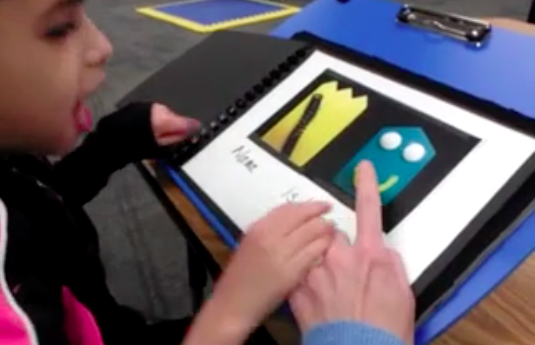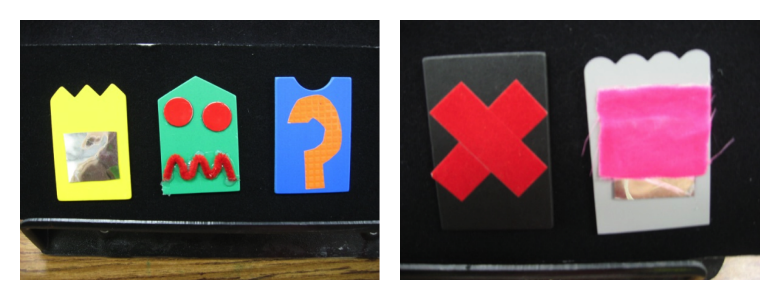Part 2: Using a Partial-Object Based Communication System for Literacy
The majority of Augmentative and Alternative Communication (AAC) systems available today use visually-based symbols. Often, however, students with Multiple Disabilities including Visual Impairments (MDVI) struggle with seeing and interpreting these two-dimensional, flat visual images. This is often due to MDVI students having Cortical Visual Impairment (CVI), which typically impacts the ability to interpret and understand flat picture and line drawing based images. In Dr. Roman-Lantzy’s book, “Cortical Visual Impairment: An Approach to Assessment and Intervention”, she states that children who are not yet in Phase 3 (scores of 6 or less) will struggle with using two-dimensional images (page 134). This means that many of our students with CVI who are visual learners (based on their Learning Media Assessment) will need to use a Partial-Object based symbol system for communication rather than a flat line-drawing based system. For more information on this, check out my previous blog on the topic.
Now I am one of those teachers who just don’t want to take “No” for an answer, the kind of teacher who is unwilling to give up on something meaningful and important just because it doesn’t work out at first. I also am 100% dedicated to ALL of my students having a way to communicate and engage in literacy – ESPECIALLY the ones who have multiple disabilities. And I know that you are reading this post because YOU are also just as dedicated! Yes you CAN develop a symbol system that works for these students who have CVI and are MD. The first step in this process is to develop an individualized communication system that uses 3-dimensional objects and parts of objects for communication purposes. One tool is to use the APH’s “Tactile Connections” kit to create a communication system that uses parts of actual objects. Once you have made a partial-object based symbol system and have started teaching the student how to use it for communication, the next step is to start applying this system to reading and writing. This is where the fun really begins!

Reading with Partial-Object Symbols
Any time that a student sees their partial object symbols and has to think about what they mean, they are in fact “reading” these symbols. While it may not be the traditional reading we think of using the alphabet, it is in fact looking at an abstract symbol and understanding the meaning behind it, which is basically what reading is. So if you present a symbol for the word “walk” to the student and say “Let’s do this!”, and they then look at the symbol, remember what it means, and get up and walk, they have actually READ their version of the word walk. Pretty cool right! The key is using these symbols in a meaningful and hands on way instead of constantly quizzing the student. As teachers, our tendency is often to ask something like “what does this say?” or “find the word walk”. These kinds of questions are really a quiz and are completely un-motivating to most typical students much less one who has multiple disabilities. What will motivate our students is to work on reading their symbols within multi-sensory, hands-on, and FUN activities. For example, let the student read and choose from a variety of action words to do, such as walk, run, dance, wave, clap, and so on. Or read and choose from feelings words and act out the feelings. Or read and choose from words like you and me and take turns doing something fun.

My experience is that the more we can use the student’s communication system within hands-on sensory experiences, the more fluent they will become with their symbols. For more on using sensory activities to improve literacy skills, watch my webinar on the topic.
It is also important to make books and other reading materials using the symbol system. You can either add symbols into a book that you already have, or make a special book using just their symbols.

A challenge here is that making a permanent book requires having more than 1 of each partial-object symbol, so be sure to think about this fact when creating your system and try to choose physical items in which multiples are available. What I have found to be most effective is to custom-make books using partial object symbols that are on topics that are motivating to the student. For example, my student read her symbols to help make a book called “Happy People”. Each page had a person’s name and a feeling, and to this day this particular book is my student’s favorite (mom happy, I excited, you tired, teacher funny, and so on).

Writing with Partial Object Symbols
When a student uses their partial-object symbols to record a message, they are in fact writing. Once again, this doesn’t look much like traditional writing using the alphabet to record a message using letters and words! Rest assured that using a symbol to record a message in a way that is permanent for someone else to view and understand later is in fact what writing is all about. So, when a student takes the symbols for “I + like + drink” and Velcro’s them onto a page and gives that to their teacher or parent to read later, they have REALLY written a sentence using their symbol system! My experience is that authentic and even intense experiences invoke meaningful writing. One day, my student was really mad at me because I wanted her to work and she wanted to play hide and seek, so we ended up writing sentences about her feelings. I set up a “sentence starter” with her symbols that said “I + mad + when…” and she finished several sentences based on her feelings at the time. I tried not to be too upset when the first two sentences she wrote were “I mad when…Ms. Faye” and “I mad when…no hide”!

Using partial object symbols to make lists is a great way to get started with writing as well. Let your student choose what to write about –make lists like My Favorite People, Things I Like, I Can Move, or even something like Silly Stuff where you try to just put symbols together that are silly. Megan Mogan has some wonderful insights on this topic as well. The most exciting thing for my students is using their partial-object symbols to write their own books. Seeing their own name as the author and re-reading books they wrote themselves is very special indeed! Hello literacy!





